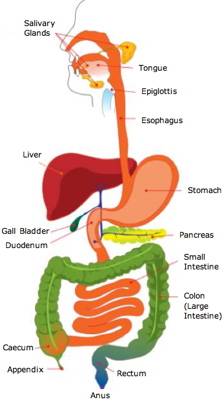Human Digestive System
Online Biology Dictionary

|
The human digestive system breaks down food mechanically and then converts it chemically into substances that can be absorbed by the body.
Simple sugars are, for the most part, absorbed unchanged. However, starch, fats, and proteins generally need to be broken down by the digestive fluids before they can be utilized. A variety of enzymes perform this function, each having particular substrates upon which it can act. For example, the enzyme amylase, present in saliva, breaks down starch into sugar. Similarly, in the stomach the enzyme pepsin breaks down proteins into short peptides.
The digestive tract is composed of the organs shown in the figure at right. In the mouth, the tongue and teeth crush food and mix it with saliva. When swallowed the masticated food passes down the esophagus to the stomach. As the food passes the glottis, the epiglottis closes to prevent choking.
The stomach secretes acidic digestive fluids which aid in breaking down the food (pepsin is active only in an acidic solution).
Bile is produced in the liver and stored in the gall bladder. Within the small intestine, bile acts as a surfactant, coating lipid particles, allowing their dispersion, and thus making them accessible to the enzyme pancreatic lipase, which breaks them down into simpler molecules that can be absorbed through the walls of the intestine.
The large intestine absorbs water from the matter passed undigested through the small intestine. It then ejects the dehydrated waste from the body.
Most shared on Macroevolution.net:
Human Origins: Are we hybrids?
On the Origins of New Forms of Life
Mammalian Hybrids
Cat-rabbit Hybrids: Fact or fiction?
Famous Biologists
Dog-cow Hybrids
Georges Cuvier: A Biography
Prothero: A Rebuttal
Branches of Biology
Dog-fox Hybrids